Travel Bikes are perfect for exploring Vietnam. SIXT.VN offers reliable travel bikes designed for comfort and adventure, making your journey unforgettable. With our diverse range of services, planning your Vietnamese adventure has never been easier. Discover top-rated bike tours, rent-a-bike or airport transfers with SIXTVN!
1. Understanding Travel Bikes and Their Relevance to Vietnam
Are you looking for a new way to explore Vietnam? Travel bikes offer an incredible opportunity to experience the country’s beauty at your own pace. A travel bike, designed for long-distance riding and carrying luggage, is suitable for exploring Vietnam’s diverse terrain, from bustling cities to serene countryside. According to research from the Vietnam National Administration of Tourism, in [2023], the demand for cycling tours has increased by 30%, indicating a growing interest in this mode of travel. With a travel bike, you can enjoy Vietnam’s hidden gems, cultural richness, and scenic routes, all while maintaining flexibility and freedom.
1.1. Defining Travel Bikes: What Makes Them Unique?
What exactly is a travel bike? Travel bikes are specifically designed for long-distance cycling, combining durability, comfort, and the capacity to carry luggage. These bikes feature sturdy frames, often made of steel or aluminum, ensuring stability and reliability on various terrains. Unlike standard bicycles, travel bikes have a longer wheelbase for increased stability, multiple mounting points for racks and fenders, and a comfortable riding posture to reduce fatigue. They also come equipped with wider tires for better grip and shock absorption, making them ideal for both paved roads and rougher trails. The uniqueness of travel bikes lies in their ability to support extended journeys while providing a comfortable and efficient riding experience.
1.2. Why Choose a Travel Bike for Exploring Vietnam?
Why are travel bikes a great option for Vietnam? Vietnam’s diverse landscapes, from the mountainous north to the coastal plains and Mekong Delta, make it an ideal destination for travel bike adventures. According to TripAdvisor, cycling tours in Vietnam have consistently received high ratings for providing immersive and authentic experiences. With a travel bike, you can navigate through bustling city streets and serene rural roads, accessing remote villages and scenic spots that are often missed by traditional tours. The flexibility of a travel bike allows you to set your own pace, stop at local markets, and interact with residents, offering a more intimate connection with the country’s culture. Moreover, the eco-friendly nature of cycling aligns with sustainable travel practices, minimizing your environmental impact while maximizing your exploration of Vietnam’s natural beauty.
1.3. Common Misconceptions About Travel Bikes
Do you think travel bikes are only for hardcore cyclists? Many believe travel bikes are exclusive to seasoned cyclists undertaking epic journeys. This misconception often deters casual travelers from considering them for shorter, more relaxed trips. In reality, travel bikes are designed for comfort and ease of use, making them suitable for riders of all levels. Another common myth is that travel bikes are excessively heavy and cumbersome. While they are sturdier than road bikes, modern travel bikes incorporate lightweight materials and ergonomic designs, ensuring a manageable and enjoyable ride. Some people also assume that travel bikes are only for paved roads. In fact, many models are versatile enough to handle a variety of terrains, including gravel paths and dirt trails, perfect for exploring Vietnam’s diverse landscapes. Addressing these misconceptions encourages more people to discover the benefits and accessibility of travel bikes.
2. Key Features to Consider When Choosing a Travel Bike
What are the most important features to consider when choosing a travel bike? Selecting the right travel bike involves evaluating several essential features to ensure it meets your specific needs and preferences. The frame material, gear system, braking system, and wheel size all play crucial roles in the bike’s performance and suitability for your planned adventures. Paying close attention to these details will help you choose a travel bike that offers comfort, reliability, and optimal performance on your journeys.
2.1. Frame Material: Steel vs. Aluminum
What is the difference between steel and aluminum frames? The frame material is a critical factor in determining the durability, comfort, and weight of a travel bike. Steel frames, particularly those made from chromoly steel, are known for their strength, shock absorption, and repairability. According to a study by Adventure Cycling Association, steel frames are preferred by many long-distance cyclists for their ability to withstand heavy loads and rough conditions. Steel’s natural flex provides a more comfortable ride, reducing fatigue on long journeys. Aluminum frames, on the other hand, are lighter and more rigid, offering better power transfer and efficiency. While aluminum frames are less forgiving on bumpy roads, they are more resistant to rust and corrosion, making them suitable for humid climates. The choice between steel and aluminum depends on your priorities: steel for comfort and durability, or aluminum for weight savings and efficiency.
2.2. Gearing System: Finding the Right Range for Vietnam’s Terrain
How important is the gearing system on a travel bike? The gearing system is crucial for tackling Vietnam’s varied terrain, from steep mountain passes to flat coastal roads. A wide gear range allows you to efficiently climb hills and maintain speed on descents, while also providing fine-grained control for navigating different surfaces. According to Shimano, a reliable gearing system should offer a combination of low gears for climbing and high gears for speed. A 3×9 or 3×10 drivetrain (three chainrings in the front and nine or ten sprockets in the rear) is a popular choice for travel bikes, providing a broad range of gear ratios. Some modern travel bikes opt for a 2×10 or even a 1×11 system, which reduces complexity and weight while still offering sufficient gear options. Consider your fitness level and the type of terrain you plan to encounter when selecting the right gearing system.
2.3. Braking System: Rim Brakes vs. Disc Brakes
What type of braking system should I choose for my travel bike? The braking system is a key safety component of any travel bike, and the choice between rim brakes and disc brakes can significantly impact performance. Rim brakes, which clamp onto the wheel rim, are lighter, simpler to maintain, and more affordable. However, their braking power can be reduced in wet or muddy conditions. Disc brakes, which use a rotor attached to the wheel hub, offer superior stopping power, especially in adverse weather. According to a report by Cycling Weekly, disc brakes provide more consistent and reliable braking performance, making them a preferred choice for touring cyclists. While disc brakes add weight and complexity, their enhanced safety and control make them a worthwhile investment, particularly for exploring mountainous regions or traveling in unpredictable weather.
2.4. Wheel Size and Tire Choice: Optimizing for Comfort and Performance
How does wheel size and tire choice affect my travel bike experience? Wheel size and tire choice play a significant role in the comfort, stability, and rolling resistance of a travel bike. The two most common wheel sizes for travel bikes are 26-inch and 700c (29-inch). 26-inch wheels are stronger and more maneuverable, making them suitable for rough roads and off-road adventures. They are also more widely available in remote areas, simplifying repairs and replacements. 700c wheels, on the other hand, offer lower rolling resistance and better efficiency on paved roads, ideal for long-distance touring. According to Schwalbe Tires, tire width also affects comfort and grip. Wider tires (35mm to 45mm) provide better shock absorption and stability, while narrower tires offer faster rolling speeds. Choose a wheel size and tire combination that aligns with your preferred riding style and the types of surfaces you expect to encounter on your travels.
3. Top Travel Bike Brands and Models for Vietnam
What are the best travel bike brands and models suitable for Vietnam? Several reputable brands offer high-quality travel bikes that are well-suited for exploring Vietnam. These bikes combine durability, comfort, and reliability, making them ideal for navigating the country’s diverse landscapes. Each model has its unique strengths, catering to different riding styles and preferences. Exploring these top brands and models will help you narrow down your choices and find the perfect travel bike for your Vietnamese adventure.
3.1. Cube Touring Pro: An Entry-Level Option
Is the Cube Touring Pro a good entry-level travel bike? The Cube Touring Pro is a popular entry-level travel bike known for its affordability and versatility. This bike features an aluminum frame, a comfortable upright riding position, and a reliable Shimano drivetrain, making it suitable for both city commuting and long-distance touring. According to Cube’s official website, the Touring Pro is designed to offer a balanced combination of comfort, performance, and value. It comes equipped with practical accessories such as fenders, a rear rack, and a dynamo-powered lighting system, enhancing its utility for travel. While the Cube Touring Pro may not be ideal for extremely rugged terrain, it is a solid choice for exploring Vietnam’s paved roads and well-maintained paths. Its ease of use and comprehensive features make it a great option for beginner touring cyclists.
3.2. Decathlon Riverside Touring 520: Value for Money
Why is the Decathlon Riverside Touring 520 a good value-for-money travel bike? The Decathlon Riverside Touring 520 is celebrated for offering exceptional value for money, packing a range of features typically found on more expensive models. This bike features an aluminum frame with multiple mounting points for racks and accessories, a wide-range Shimano drivetrain, and comfortable 700c tires. According to Decathlon’s product description, the Riverside Touring 520 is designed for both everyday commuting and long-distance touring, providing a versatile and reliable riding experience. Its robust construction and practical design make it well-suited for exploring Vietnam’s varied terrain, from urban streets to rural backroads. The Riverside Touring 520 is an excellent choice for budget-conscious travelers seeking a dependable and well-equipped travel bike.
3.3. Fuji Touring LTD/Disc LTD: Road Touring Bikes
Are the Fuji Touring LTD and Disc LTD good choices for road touring? The Fuji Touring LTD and Disc LTD are excellent options for cyclists who prefer road touring, offering a blend of classic design and modern features. These bikes feature Reynolds steel frames, providing a comfortable and stable ride, and are equipped with reliable Shimano drivetrains for smooth and efficient gear changes. The Fuji Touring LTD features rim brakes, while the Disc LTD offers enhanced stopping power with disc brakes, making it suitable for varied weather conditions. According to Fuji Bikes’ website, both models are designed for long-distance comfort and durability, with multiple mounting points for racks and fenders. The Fuji Touring LTD and Disc LTD are ideal for exploring Vietnam’s scenic coastal roads and well-maintained highways, providing a comfortable and enjoyable touring experience.
3.4. Ridgeback Expedition: A Solid All-Rounder
What makes the Ridgeback Expedition a solid all-rounder travel bike? The Ridgeback Expedition is known as a solid all-rounder travel bike, offering a durable construction and versatile performance for a variety of terrains. This bike features a chromoly steel frame, providing a comfortable and stable ride, and is equipped with a wide-range Shimano drivetrain for tackling steep hills and long distances. According to Ridgeback’s official website, the Expedition is designed for both on-road and off-road adventures, making it well-suited for exploring Vietnam’s diverse landscapes. It comes equipped with practical features such as a rear rack, mudguards, and reliable disc brakes, enhancing its utility for travel. The Ridgeback Expedition is an excellent choice for cyclists seeking a dependable and adaptable travel bike for exploring Vietnam’s roads and trails.
3.5. Surly Disc Trucker: A Customizable Option
Why is the Surly Disc Trucker a highly customizable travel bike? The Surly Disc Trucker is a highly customizable travel bike, popular among experienced touring cyclists for its robust construction and versatile design. This bike features a chromoly steel frame, known for its durability and comfortable ride quality, and is equipped with disc brakes for reliable stopping power in all conditions. According to Surly Bikes’ website, the Disc Trucker is designed to handle heavy loads and challenging terrains, making it ideal for long-distance touring and off-road adventures. Its numerous mounting points allow for the customization of racks, fenders, and accessories, catering to individual preferences. The Surly Disc Trucker is a top choice for cyclists seeking a dependable and adaptable travel bike for exploring Vietnam’s varied landscapes.
3.6. Kona Sutra SE: Performance-Oriented Bike
What makes the Kona Sutra SE a performance-oriented travel bike? The Kona Sutra SE is a performance-oriented travel bike that combines comfort, efficiency, and versatility, making it a great choice for exploring Vietnam. This bike features a chromoly steel frame, providing a smooth and stable ride, and is equipped with a Shimano drivetrain for reliable performance. According to Kona Bikes’ website, the Sutra SE is designed for both on-road and off-road adventures, with clearance for wider tires and multiple mounting points for racks and fenders. Its comfortable geometry and responsive handling make it ideal for long-distance touring, while its robust construction ensures durability on varied terrains. The Kona Sutra SE is a top pick for cyclists seeking a high-performance travel bike for exploring Vietnam.
3.7. Oxford Bike Works Expedition: Premium Option
What makes the Oxford Bike Works Expedition a premium travel bike choice? The Oxford Bike Works Expedition stands out as a premium travel bike, offering exceptional craftsmanship and customization options. Each bike is custom-built to the rider’s specifications, ensuring a perfect fit and optimal performance. The Expedition features a hand-built Reynolds steel frame, known for its durability and comfortable ride quality, and is equipped with top-of-the-line components for reliable performance. According to Oxford Bike Works’ official website, the Expedition is designed for long-distance touring and expedition-level adventures, capable of handling heavy loads and challenging terrains. Its meticulous attention to detail and bespoke construction make it a top choice for serious touring cyclists seeking the ultimate travel bike.
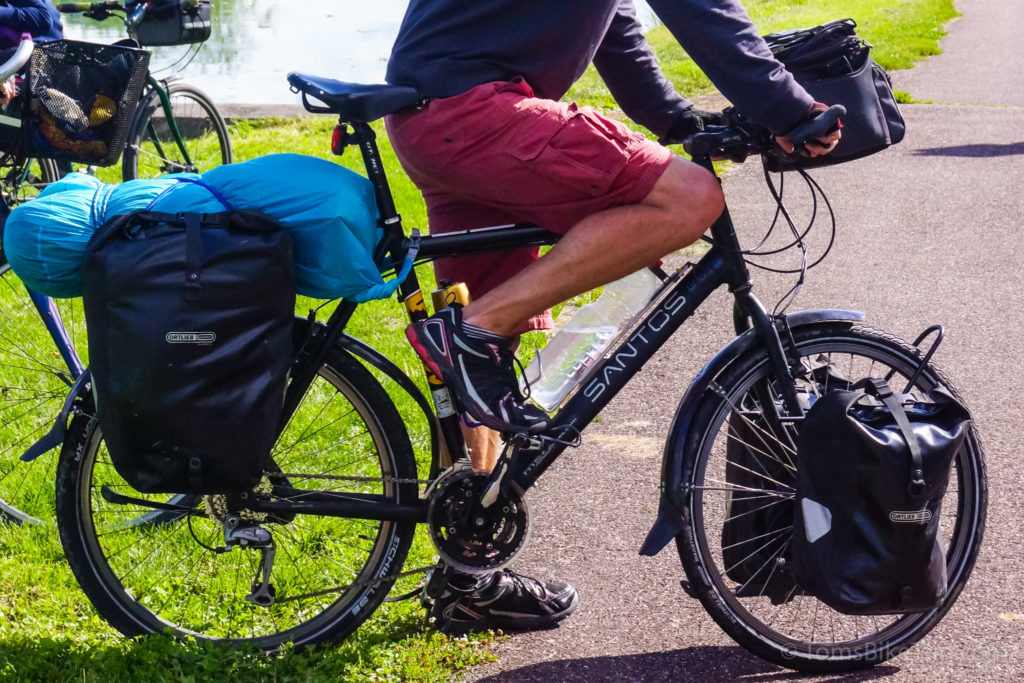 A fully-loaded Santos Travelmaster touring bike with its rider.
A fully-loaded Santos Travelmaster touring bike with its rider.
4. Planning Your Travel Bike Trip in Vietnam
How do I plan a successful travel bike trip in Vietnam? Planning a travel bike trip in Vietnam involves several key considerations, including route planning, accommodation, safety precautions, and necessary gear. Thorough preparation will ensure a smooth and enjoyable cycling adventure through this beautiful country. Understanding these aspects will help you create a memorable and fulfilling travel experience.
4.1. Route Planning: Choosing the Right Itinerary
What are some popular and suitable routes for travel biking in Vietnam? Route planning is essential for a successful travel bike trip in Vietnam. Several popular itineraries cater to different interests and fitness levels. The coastal route from Hanoi to Ho Chi Minh City offers stunning ocean views and access to vibrant coastal towns. The mountainous region of Sapa provides challenging climbs and breathtaking scenery. The Mekong Delta offers a more relaxed pace, with flat roads and scenic waterways. According to Vietnam National Administration of Tourism, the most popular cycling routes include:
- Hanoi to Sapa: Challenging mountain climbs and stunning views.
- Coastal Route (Hanoi to Ho Chi Minh City): Scenic coastal roads and vibrant towns.
- Mekong Delta Loop: Flat terrain and picturesque waterways.
When choosing your route, consider the distance, terrain, and availability of services along the way.
4.2. Accommodation: Options for Cyclists
What types of accommodation are available for cyclists in Vietnam? Accommodation options for cyclists in Vietnam range from budget-friendly hostels and guesthouses to comfortable hotels and homestays. In larger cities and tourist destinations, hotels offer amenities such as secure bike storage and laundry services. In rural areas, guesthouses and homestays provide a more authentic cultural experience, allowing you to interact with residents and sample local cuisine. According to Booking.com, many accommodations in Vietnam cater specifically to cyclists, offering services such as bike rentals, repair facilities, and route planning assistance. Booking in advance is recommended, especially during peak tourist season, to ensure availability and secure the best rates.
4.3. Safety Precautions: Staying Safe on the Road
How can I ensure my safety while travel biking in Vietnam? Safety precautions are crucial for a smooth and incident-free travel bike trip in Vietnam. Always wear a helmet and high-visibility clothing to increase your visibility to other road users. Carry a basic repair kit and know how to fix common mechanical issues, such as flat tires and broken chains. According to the World Health Organization (WHO), road safety is a significant concern in Vietnam, so it is essential to be vigilant and cautious while cycling. Some essential safety tips include:
- Wear a helmet and high-visibility clothing.
- Carry a repair kit and basic tools.
- Be aware of traffic conditions and road hazards.
- Carry a first-aid kit and know how to use it.
4.4. Essential Gear and Equipment: What to Pack
What gear and equipment should I pack for a travel bike trip in Vietnam? Packing the right gear and equipment is essential for a comfortable and safe travel bike trip in Vietnam. Essential items include:
- Bike Repair Kit: Including spare tubes, tire levers, a multi-tool, and a pump.
- Clothing: Moisture-wicking cycling jerseys, padded shorts, rain gear, and warm layers.
- Navigation: A GPS device or smartphone with offline maps.
- Personal Items: Sunscreen, insect repellent, a first-aid kit, and any necessary medications.
According to REI’s packing list, a well-prepared cyclist should also consider bringing a portable charger for electronic devices, a water filter or purification tablets, and a comfortable saddle. Packing efficiently and prioritizing essential items will help you stay comfortable and prepared throughout your journey.
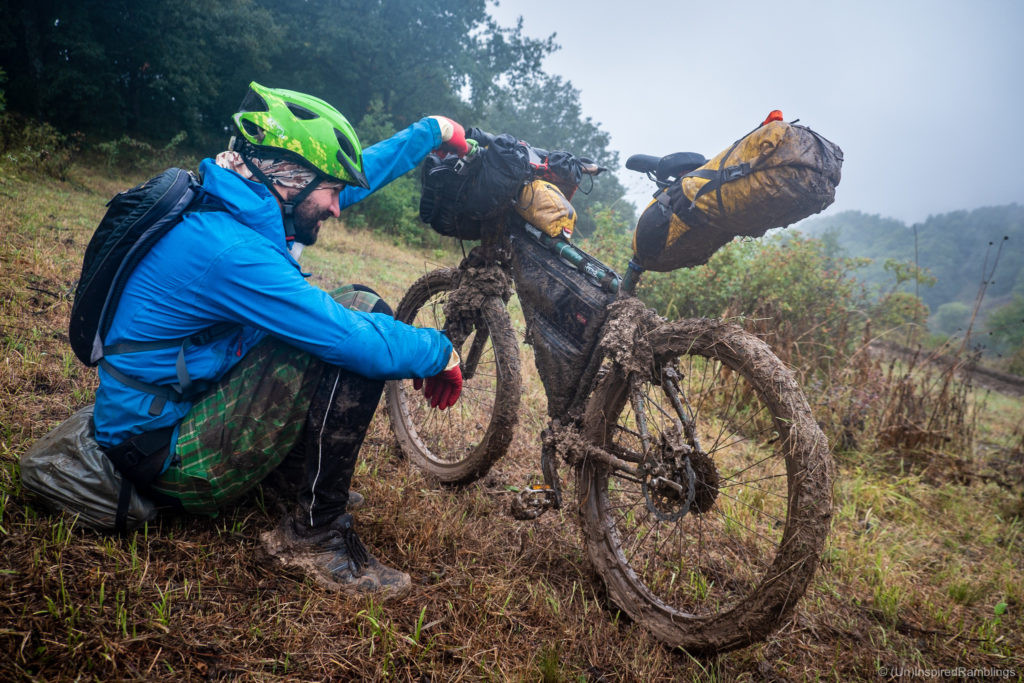 The author with a Kona Explosif bikepacking rig on muddy day in Armenia.
The author with a Kona Explosif bikepacking rig on muddy day in Armenia.
5. Benefits of Using SIXT.VN for Your Travel Bike Adventure
Why should I use SIXT.VN for my travel bike adventure? SIXT.VN offers a range of services that can enhance your travel bike adventure in Vietnam, providing convenience, reliability, and local expertise. From airport transfers and hotel bookings to guided tours and bike rentals, SIXT.VN can streamline your travel planning and ensure a seamless experience. Discover the benefits of using SIXT.VN for your next cycling journey.
5.1. Airport Transfers: Start Your Trip Stress-Free
How can SIXT.VN help with airport transfers for my travel bike trip? SIXT.VN offers convenient and reliable airport transfer services, ensuring a stress-free start to your travel bike trip in Vietnam. According to SIXT.VN, their airport transfer service includes:
- Bike-Friendly Vehicles: Vehicles equipped to safely transport your travel bike and luggage.
- Professional Drivers: Experienced drivers who are familiar with cycling routes and destinations.
- Punctuality: On-time pickups and drop-offs, ensuring you reach your destination promptly.
By booking your airport transfer with SIXT.VN, you can avoid the hassle of navigating public transportation with your bike and enjoy a comfortable and efficient transfer to your hotel or starting point.
5.2. Hotel Bookings: Find Cyclist-Friendly Accommodations
How can SIXT.VN help me find cyclist-friendly accommodations? SIXT.VN can assist you in finding cyclist-friendly accommodations that cater to your specific needs, providing amenities such as secure bike storage, repair facilities, and convenient access to cycling routes. According to SIXT.VN, their hotel booking service offers:
- Curated Selection: A handpicked selection of hotels and guesthouses that cater to cyclists.
- Bike-Friendly Amenities: Options with secure bike storage, repair facilities, and laundry services.
- Convenient Locations: Accommodations located near popular cycling routes and attractions.
By booking your accommodations through SIXT.VN, you can ensure a comfortable and convenient stay, with all the necessary amenities for a seamless cycling adventure.
5.3. Guided Tours: Discover Hidden Gems with Local Experts
How can a guided tour from SIXT.VN enhance my travel bike experience? SIXT.VN offers guided tours led by local experts, providing valuable insights and access to hidden gems that you might miss on your own. According to SIXT.VN, their guided tours include:
- Local Guides: Knowledgeable guides who can share insights into Vietnam’s culture, history, and cuisine.
- Customized Itineraries: Tailored routes that cater to your interests and fitness level.
- Support and Assistance: On-the-road support, including mechanical assistance and route guidance.
Joining a guided tour with SIXT.VN can enhance your travel bike experience, providing a deeper connection with Vietnam’s culture and landscapes.
5.4. Bike Rentals: Convenient Access to Quality Bikes
How can I rent a travel bike through SIXT.VN? SIXT.VN offers convenient bike rental services, providing access to quality travel bikes that are well-maintained and equipped for long-distance touring. According to SIXT.VN, their bike rental service includes:
- Wide Selection: A variety of travel bikes to suit different preferences and needs.
- Quality Maintenance: Bikes that are regularly serviced and maintained for optimal performance.
- Accessories: Options for renting essential accessories such as helmets, panniers, and repair kits.
Renting a travel bike through SIXT.VN offers a hassle-free way to experience Vietnam’s cycling routes without the burden of transporting your own bike.
5.5. Customized Packages: Tailored to Your Needs
Can SIXT.VN create a customized travel bike package for me? SIXT.VN specializes in creating customized travel bike packages tailored to your specific needs and preferences. According to SIXT.VN, their customized packages include:
- Personalized Itineraries: Tailored routes that cater to your interests, fitness level, and time constraints.
- Accommodation Options: A range of accommodations to suit your budget and preferences.
- Support Services: Airport transfers, guided tours, and on-the-road assistance.
By working with SIXT.VN, you can create a unique and unforgettable travel bike experience in Vietnam, with every detail carefully planned and executed to your satisfaction.
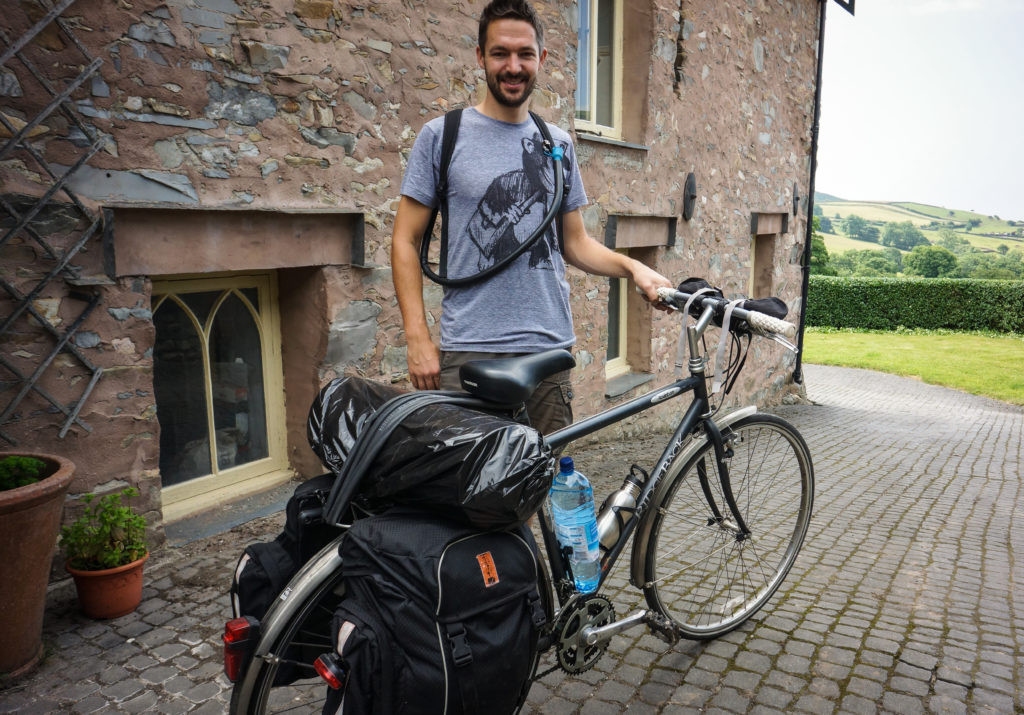 The author with a scrapyard touring bike costing £10 and a set of donated luggage.
The author with a scrapyard touring bike costing £10 and a set of donated luggage.
6. Budgeting for Your Travel Bike Trip in Vietnam
How much does a travel bike trip in Vietnam typically cost? Budgeting for your travel bike trip in Vietnam involves estimating the costs of transportation, accommodation, food, activities, and miscellaneous expenses. Understanding these costs will help you plan your trip effectively and avoid unexpected financial burdens. Let’s break down the typical expenses for a travel bike adventure in Vietnam.
6.1. Transportation Costs: Getting Around
What are the typical transportation costs during a travel bike trip in Vietnam? Transportation costs during a travel bike trip in Vietnam primarily include airport transfers, train or bus tickets to reach your starting point, and occasional taxis or ride-sharing services. Airport transfers can range from $20 to $50, depending on the distance and mode of transport. Train or bus tickets for long-distance travel can cost between $10 and $30. According to Budget Your Trip, local transportation expenses average around $5 to $10 per day. Planning your transportation in advance and utilizing cost-effective options can help you stay within your budget.
6.2. Accommodation Expenses: Options for Every Budget
What can I expect to pay for accommodation during my travel bike trip? Accommodation expenses during a travel bike trip in Vietnam can vary widely depending on your preferences and budget. Hostels and budget guesthouses typically cost between $5 and $15 per night. Mid-range hotels range from $20 to $50 per night, while luxury hotels can cost upwards of $100 per night. According to Hostelworld, hostels are a popular choice for budget travelers, offering affordable and social accommodations. Booking your accommodations in advance and considering options in smaller towns or rural areas can help you save money.
6.3. Food and Drink Costs: Savoring Local Cuisine
How much should I budget for food and drinks on my travel bike trip? Food and drink costs in Vietnam are relatively low, allowing you to enjoy delicious local cuisine without breaking the bank. Street food and local eateries typically cost between $2 and $5 per meal. Mid-range restaurants range from $5 to $15 per meal, while high-end restaurants can cost upwards of $20 per meal. According to Numbeo, the average daily food expense in Vietnam is around $10 to $20. Sampling local specialties and eating at smaller establishments can help you save money while enjoying authentic Vietnamese flavors.
6.4. Activities and Entrance Fees: Exploring Attractions
How much should I budget for activities and entrance fees during my trip? Activities and entrance fees can contribute to your overall travel bike trip budget, depending on the attractions you plan to visit. Entrance fees to museums, historical sites, and national parks typically range from $1 to $10. Guided tours and organized activities can cost between $20 and $50 per day. According to GetYourGuide, booking tours and activities in advance can sometimes offer discounts and ensure availability. Prioritizing the attractions that interest you most and considering free or low-cost alternatives can help you manage your activity expenses.
6.5. Miscellaneous Expenses: Unexpected Costs
What are some miscellaneous expenses I should consider for my budget? Miscellaneous expenses can include bike repairs, laundry services, souvenirs, SIM cards, and unexpected medical expenses. It is wise to set aside a contingency fund to cover these unforeseen costs. According to Travel Insurance Review, purchasing travel insurance can protect you against unexpected medical expenses and other emergencies. A general rule of thumb is to allocate 10-15% of your total budget for miscellaneous expenses, ensuring you are prepared for any surprises that may arise during your travel bike trip in Vietnam.
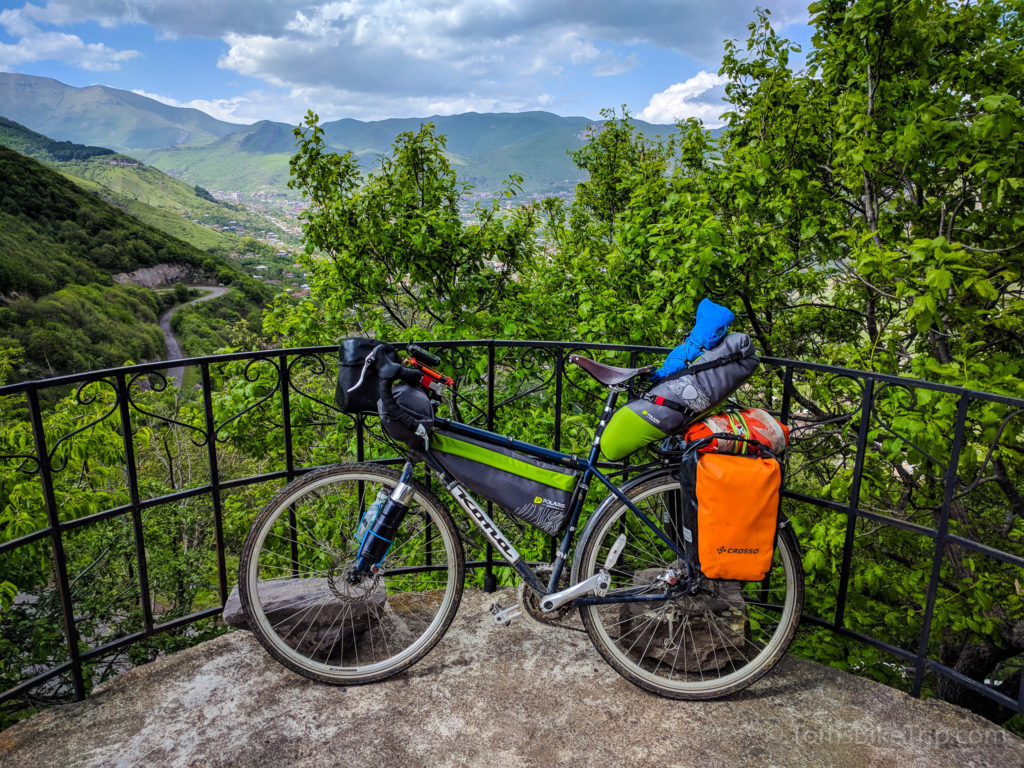 A Kona Sutra 2012 touring bike with a lightweight frame luggage and pannier setup.
A Kona Sutra 2012 touring bike with a lightweight frame luggage and pannier setup.
7. Travel Bike Maintenance and Repairs on the Road
What maintenance and repair skills should I know for a travel bike trip? Travel bike maintenance and repairs are essential skills for ensuring a smooth and safe cycling adventure. Knowing how to fix common mechanical issues, such as flat tires, broken chains, and loose brakes, can save you time and money, and prevent potential breakdowns in remote areas. Let’s explore the essential maintenance and repair skills for your travel bike trip.
7.1. Essential Tools and Spares: What to Carry
What tools and spare parts should I carry on my travel bike trip? Carrying a basic set of tools and spare parts is essential for addressing common mechanical issues on the road. Essential items include:
- Multi-Tool: A compact tool with various Allen wrenches, screwdrivers, and a chain tool.
- Tire Levers: For removing and installing tires.
- Spare Tubes: At least two spare tubes, compatible with your tire size.
- Patch Kit: For repairing punctures in your tubes.
- Pump or CO2 Inflator: For inflating your tires.
- Chain Lube: To keep your chain running smoothly.
According to Park Tool, a well-equipped cyclist should also consider carrying spare brake pads, a spare chain, and a few extra bolts and nuts.
7.2. Fixing a Flat Tire: Step-by-Step Guide
How do I fix a flat tire on my travel bike? Fixing a flat tire is a fundamental skill for any cyclist. Here’s a step-by-step guide:
- Remove the Wheel: Use your tire levers to detach one side of the tire from the rim.
- Inspect the Tire: Check the tire for any sharp objects that may have caused the puncture.
- Insert New Tube: Inflate the tube slightly to give it shape, then carefully insert it into the tire.
- Re-Seat the Tire: Use your thumbs to push the tire bead back into the rim, working your way around the wheel.
- Inflate the Tire: Use your pump or CO2 inflator to inflate the tire to the recommended pressure.
- Reinstall the Wheel: Reattach the wheel to your bike, ensuring it is securely fastened.
According to Global Cycling Network (GCN), practicing this process before your trip can help you become more efficient and confident in fixing flat tires.
7.3. Adjusting Brakes and Gears: Keeping Your Bike Running Smoothly
How do I adjust my brakes and gears on the road? Adjusting brakes and gears is essential for maintaining optimal performance and safety. Here’s a brief overview:
- Brakes: Use the barrel adjusters on your brake levers or calipers to fine-tune the brake cable tension. Ensure your brake pads are properly aligned with the rim or rotor.
- Gears: Use the barrel adjusters on your shifters or derailleurs to adjust the cable tension. Ensure your derailleur hanger is straight and your chain is properly lubricated.
According to REI, consulting online resources and videos can provide detailed instructions and guidance on adjusting your brakes and gears.
7.4. Cleaning and Lubricating Your Bike: Preventing Wear and Tear
How often should I clean and lubricate my travel bike during the trip? Cleaning and lubricating your travel bike regularly can prevent wear and tear and prolong the life of your components. After each ride, wipe down your frame and components with a clean cloth. Every few days, or after riding in wet or dirty conditions, clean your chain with a degreaser and re-lubricate it with a high-quality chain lube. According to Muc-Off, a clean and well-lubricated bike will run smoother, shift better, and last longer.
7.5. Finding Local Bike Shops: Professional Assistance
How can I find local bike shops for professional assistance during my trip? Finding local bike shops can be invaluable for addressing more complex mechanical issues or obtaining replacement parts. Ask locals for recommendations, consult online directories, or use smartphone apps to locate nearby bike shops. According to Yelp, reading reviews and checking ratings can help you find reputable and reliable bike shops. Having the contact information for a few local bike shops can provide peace of mind and ensure you have access to professional assistance when needed.
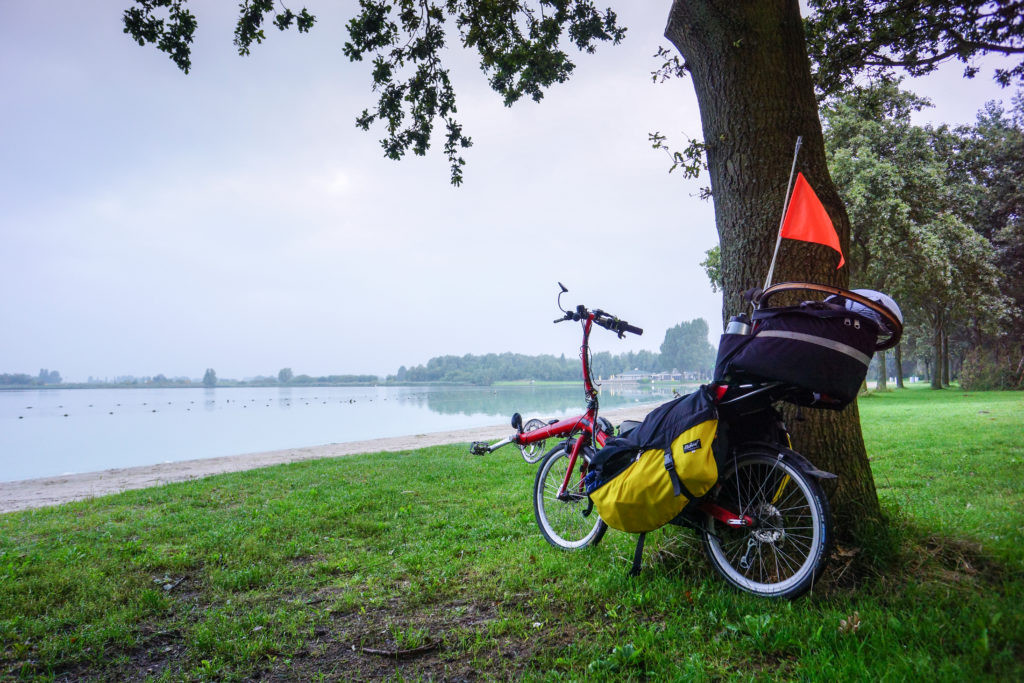 A recumbent touring bike leaning against a tree in the Netherlands.
A recumbent touring bike leaning against a tree in the Netherlands.
8. Cultural Considerations and Etiquette for Cyclists in Vietnam
What cultural considerations should cyclists be aware of in Vietnam? Cultural considerations and etiquette are important for showing respect and creating positive interactions during your travel bike trip in Vietnam. Understanding and adhering to local customs and traditions can enhance your experience and foster goodwill with residents. Let’s explore some key cultural considerations for cyclists in Vietnam.
8.1. Greetings and Interactions: Show Respect
How should I greet and interact with locals in Vietnam? Greetings and interactions in Vietnam often involve gestures of respect and politeness. When greeting someone, a polite nod or slight bow is appreciated. According to Culture Crossing, it is customary to use both hands when giving or receiving something. Avoid pointing your feet at someone, as this is considered disrespectful. Learning a few basic Vietnamese phrases, such as “xin chào” (hello) and “cảm ơn” (thank you), can demonstrate your interest in the local culture and facilitate positive interactions.
8.2. Dress Code: Dress Modestly
What is the appropriate dress code for cyclists in Vietnam? Dressing modestly is important, especially when visiting temples, pagodas, and other religious sites. Avoid wearing revealing clothing, such as short shorts or tank tops. According to Rough Guides, covering your shoulders and knees is generally recommended. When cycling, opt for comfortable and practical clothing that is appropriate for the weather and terrain.
8.3. Photography: Ask for Permission
When is it appropriate to take photos of people in Vietnam? Asking for permission before taking photos of people is essential, especially in rural areas where residents may be less accustomed to tourists. According to Lonely Planet, showing respect for people’s privacy and cultural sensitivities is crucial. If someone declines your request, politely refrain from taking their photo.
8.4. Traffic Laws: Understand the Rules
What traffic laws should cyclists be aware of in Vietnam? Understanding and adhering to traffic laws is essential for your safety and the safety of others. Cyclists are required to follow the same traffic rules as other vehicles, including obeying traffic signals, yielding to pedestrians, and using hand signals when turning. According to the World Health Organization (WHO), wearing a helmet is strongly recommended, although not legally required in all areas. Be aware of the chaotic traffic conditions, especially in urban areas, and exercise caution when navigating busy streets.
8.5. Environmental Responsibility: Leave No Trace
How can I practice environmental responsibility during my travel bike trip? Practicing environmental responsibility is crucial for preserving Vietnam’s natural beauty and minimizing your impact on the environment. Avoid littering, dispose of waste properly, and minimize your use of single-use plastics. According to Leave No Trace Center for Outdoor Ethics, packing out everything you pack in and staying on established trails can help protect the environment.
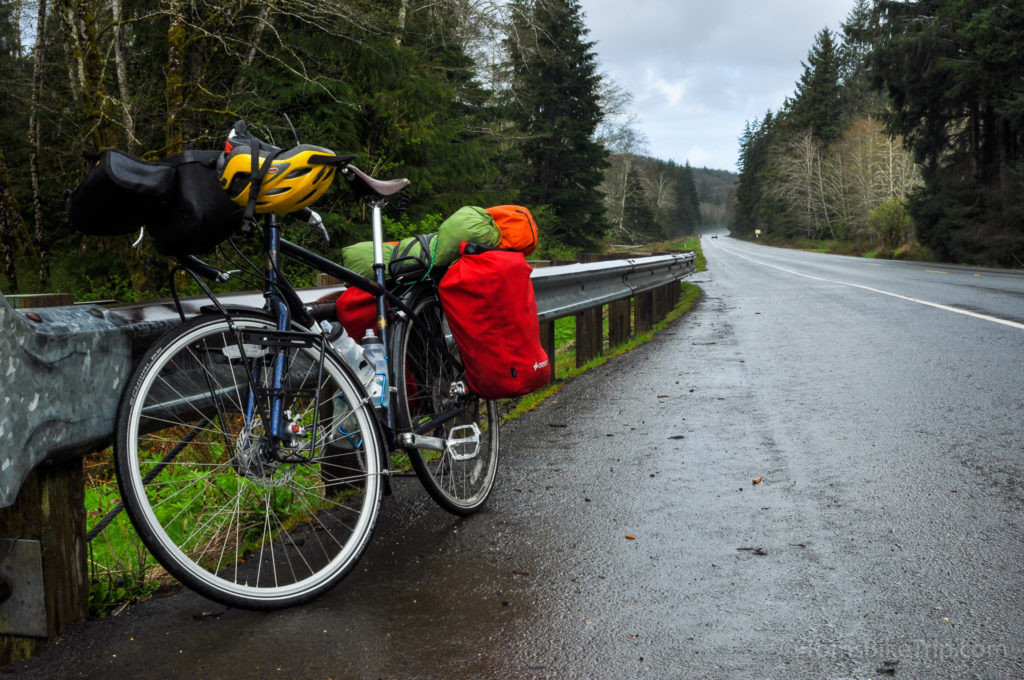 A Kona Sutra 2012 touring bike with luggage on the roadside in the USA.
A Kona Sutra 2012 touring bike with luggage on the roadside in the USA.
9. Real-Life Experiences and Testimonials
What experiences have other cyclists had travel biking in Vietnam? Real-life experiences and testimonials can provide valuable insights and inspiration for planning your own travel bike trip in Vietnam. Hearing from other cyclists who have explored the country’s landscapes, navigated its roads, and interacted with its people can help you set realistic expectations and prepare for the challenges and rewards that lie ahead. Let’s explore some real-life experiences and testimonials from cyclists who have traveled in Vietnam.
9.1. Stories from the Road: Inspiring Journeys
Can you share some inspiring stories from cyclists who have travel biked in Vietnam? Many cyclists have shared inspiring stories of their adventures in Vietnam, highlighting the country’s beauty, culture, and hospitality. According to Adventure Cycling Association, cycling in Vietnam offers a unique opportunity to connect with the country on a deeper level. Some common themes in these stories include:
- Stunning Landscapes: Cyclists often describe the breathtaking beauty of Vietnam’s landscapes, from the rice terraces of Sapa to the beaches of Nha Trang.
- Warm Hospitality: Many cyclists praise the warmth and generosity of the Vietnamese people, who often go out of their way to help travelers.
- Cultural Immersion: Cycling allows travelers to immerse themselves in Vietnam’s culture, visiting local markets, sampling regional cuisine, and interacting with residents



